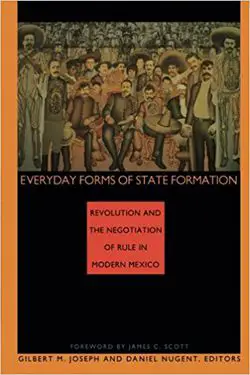Difference between revisions of "Scratching the Surface of “Everyday Forms of State Formation”"
| Line 11: | Line 11: | ||
This approach succeeds because of the pointed questions that the articles address in their own unique ways. I have summarized, and perhaps simplified, the questions addressed by the authors here in the interest of clarity and brevity: How cohesive, necessary, or confining are hegemonic projects and how do they change with practical application? How do popular mobilizations, expectations and demands influence hegemonic projects? How did the post-revolutionary State negotiate with local experiences, values and practices in order to maintain both political equilibrium and a degree of popular consent? None of the articles claim to answer every question, or even offer one answer that can be applied as a generalization to simplify the Mexican Revolution. However, taken together, this collection of articles gives the academic community a place from which to begin a sensible investigation of the meaning and legacy of the Mexican Revolution. | This approach succeeds because of the pointed questions that the articles address in their own unique ways. I have summarized, and perhaps simplified, the questions addressed by the authors here in the interest of clarity and brevity: How cohesive, necessary, or confining are hegemonic projects and how do they change with practical application? How do popular mobilizations, expectations and demands influence hegemonic projects? How did the post-revolutionary State negotiate with local experiences, values and practices in order to maintain both political equilibrium and a degree of popular consent? None of the articles claim to answer every question, or even offer one answer that can be applied as a generalization to simplify the Mexican Revolution. However, taken together, this collection of articles gives the academic community a place from which to begin a sensible investigation of the meaning and legacy of the Mexican Revolution. | ||
| − | {{Mediawiki: | + | {{Mediawiki:Mexico}} |
<div class="portal" style="width:60%;"> | <div class="portal" style="width:60%;"> | ||
==Related DailyHistory.org Articles== | ==Related DailyHistory.org Articles== | ||
Latest revision as of 01:41, 3 April 2017
The book of related articles, Everyday Forms of State Formation, Revolution and the Negotiation of Rule in Modern Mexico, is the result of a scholarly conference on the relationship between popular cultures in Mexico and the post-Revolutionary Mexican State’s hegemonic project. The complex variety and nuance often overlooked when addressing such large concepts like state, culture, hegemony and revolution are not ignored by the authors who contributed to this body of work, but are instead recognized and interrogated. After years of incomplete historical interpretation, the participants of the conference sought to understand the connection between these concepts and the actual experience of the Mexican Revolution.
The Mexican Revolution has been described by populist historians as a monolithic event, the sublime convergence of popular demands for bread and liberty. The Mexican revoutionary state’s hegemonic project was demonstrated by the state-sponsored education programs and support of muralists promoting an image of a unified and successful revolutionary experience in Mexico. In 1968 the massacre of students and protesters in Tlatelolco dispelled the illusion of the institutionalized revolutions. Many historians abandoned the grand narrative of the Revolution in favor of smaller, regional studies of specific events and experiences. These studies were limited in scope in and application, but safe from the death drop to the disillusion experienced by the intellectuals who watched their revoltutionary government disappear earnest student revolutionaries on the eve of the ’68 Olympics.
In contrast, Everyday Forms of State Formation supplies a theoretical toolkit in the first section of the text with which to understand the interplay between state formation, popular consciousness and the hegemonic process in post-Revolutionary Mexico, while also serving to explain historical processes. The theoretical articles contextualize the central concepts by analyzing other, non-Mexicanist studies of the relationships between revolution, hegemony, popular cultures and the state by other historians, including Gramsci, Scott , and Corrigan and Sayer. The work of these historians helped Mexicanists explain the inherent contradictions and limitations involved in applying any one model to understand popular culture in Mexico, the State’s hegemonic project or the revolutionary experience.
The second section provides empirical studies that both illustrate and problematize the multi-faceted and paradoxical relationships between the Mexican people and the state by examining regional and thematic revolutionary experiences. For example, the articles addressing agrarian reform by Mallon and Nugent and Alonso exemplify the historical underpinnings and hegemonic process involved in ejido and the inadequacy of simplistic interpretations of popular demands or elite motivations either or both may be hidden by liberal terminology or sarcasm.
The third section of the text reprises the theoretical concepts in light of the complicated and significant evidence. Thus armed with theory and evidence, the reader can question whether the state exists by “by defining the boundaries of the possible” (375) for individuals who, for varying reasons and to different degrees, consent to “(live) the lie” (374) and, ultimately, whether hegemony is a “problematic, contested, political process of domination and struggle” (358) that is inherently fragile and constantly changing.
This approach succeeds because of the pointed questions that the articles address in their own unique ways. I have summarized, and perhaps simplified, the questions addressed by the authors here in the interest of clarity and brevity: How cohesive, necessary, or confining are hegemonic projects and how do they change with practical application? How do popular mobilizations, expectations and demands influence hegemonic projects? How did the post-revolutionary State negotiate with local experiences, values and practices in order to maintain both political equilibrium and a degree of popular consent? None of the articles claim to answer every question, or even offer one answer that can be applied as a generalization to simplify the Mexican Revolution. However, taken together, this collection of articles gives the academic community a place from which to begin a sensible investigation of the meaning and legacy of the Mexican Revolution.
